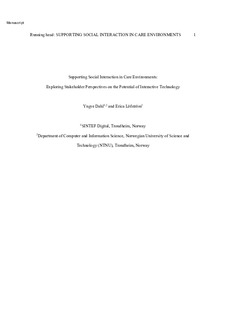Supporting Social Interaction in Care Environments: Exploring Stakeholder Perspectives on the Potential of Interactive Technology
Journal article, Peer reviewed
Accepted version

Åpne
Permanent lenke
http://hdl.handle.net/11250/2491274Utgivelsesdato
2018Metadata
Vis full innførselSamlinger
Originalversjon
International Journal of Human-Computer Interaction. 2018, . 10.1080/10447318.2018.1426897Sammendrag
This article explores care stakeholders’ perspectives on how interactive technology can help form socially active environments in residential care settings. Based on participatory workshops, involving representatives from multiple stakeholder groups, the authors identify a set of considerations relevant for design of social inclusion technology for care settings. The design considerations relate to the following topics: users, places, themes, value, and role. The authors also present three mock-ups emanating from the workshops, representing the participants’ visions as to how technology can contribute to social interaction by accommodating considerations related to the above topics. The results from this study highlight the importance of social inclusion technology being firmly anchored in the local and collaboratively produced care environment. In particular, their findings illustrate how the local—i.e., the wider social context in which the care residents live, and in which activities and things gain social meaning and value—can offer a rich design space and valuable source of inspiration for social inclusion technology. Potential negative implications of social inclusion technology are also briefly discussed. The main contribution of this article is an increased understanding of the intimate relationship between designs for social inclusion and the wider social context in which care residents live.